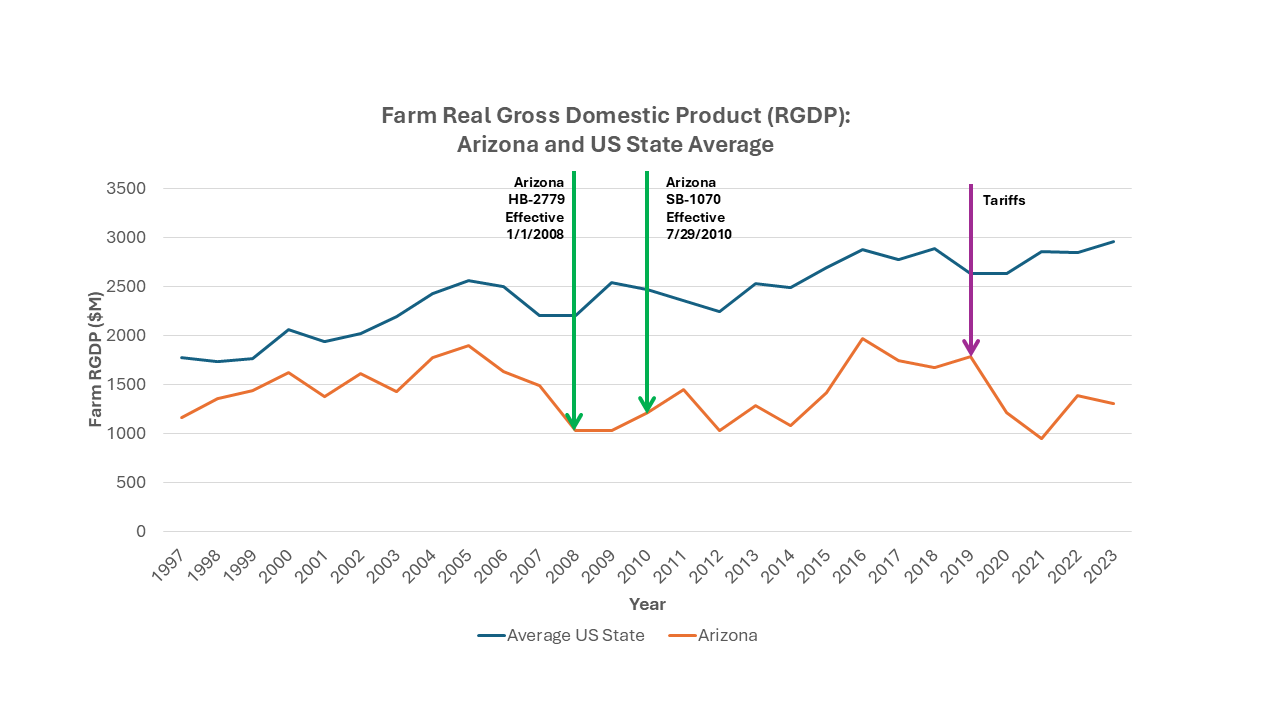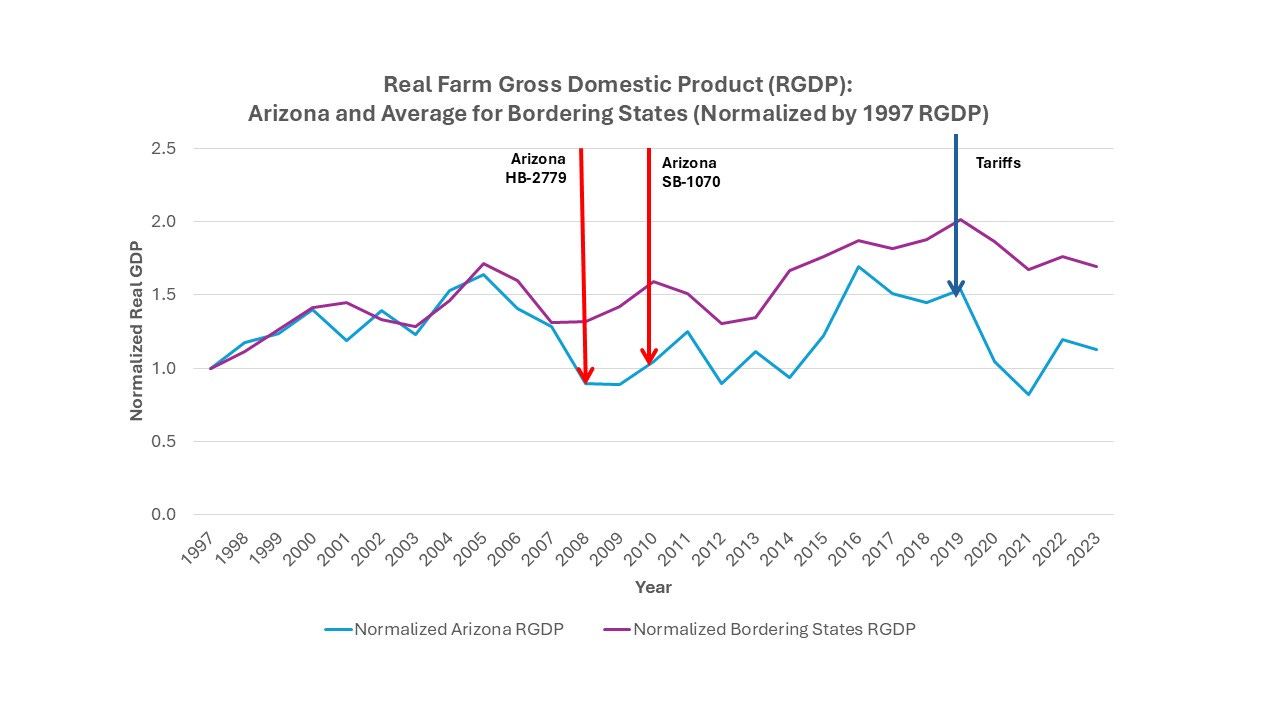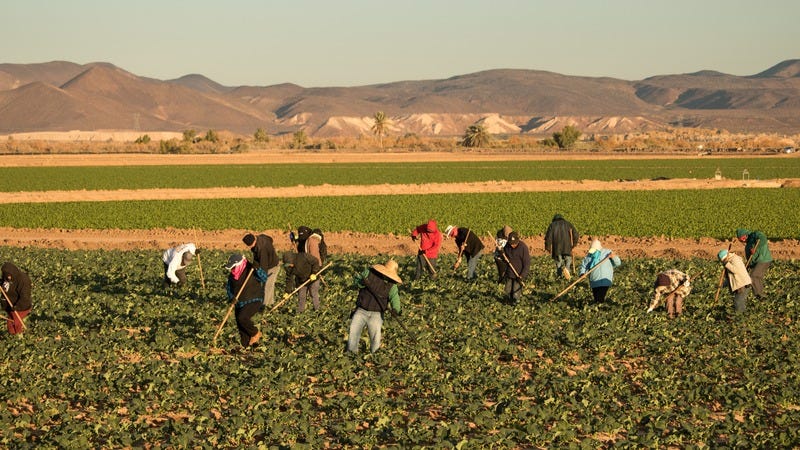Arizona in the Rear View Mirror
The First State to Declare War on Undocumented Immigrants
Note to my readers: This post is a companion to my third post (Some Already Tried This at Home) about the role of immigration in US agriculture, focusing on Arizona, the first state to pass laws based on immigrant “attrition through enforcement.” The 2007 and 2010 Arizona laws were designed to keep undocumented immigrants out of the state. In this post, I go into the details of the law and its impact on Arizona’s farmers.
Frustrated with the 2006 failure of immigration reform in Congress, Arizona decided to try state laws based on the “attrition through enforcement” philosophy to reduce their undocumented immigrant population. Recall that Kansas attorney Kris Kobach was heavily promoting this philosophy under the banner of the Center for Immigration Studies (CIS), a group that says it is pro-immigrant while spear-heading opposition to any immigration law reforms. Arizona state legislators passed Kobach-authored immigration laws in 2007 and 2010. This is interesting because CIS had been a key part of a successful campaign to defeat the 2006 reform attempt. But at that time, over half of all US federal immigration enforcement arrests were taking place in Arizona, so I can understand their “Do something about illegal immigration! Anything!” mindset. Drug-related violence, including kidnapping, was rising there. Arizonans had valid concerns about the Mexican drug cartels invading their state.
The 2007 Legal Arizona Workers Act (HB-2779), also known as the Employer Sanctions Law, was the first anti-immigration law not vetoed by Arizona’s governor. The original law (now Section 23 in the Arizona code) made it illegal for an employer to “knowingly or intentionally” hire a non-citizen employee or contractor who did not have a federal work authorization. Well, it makes sense to cut off the money flow at its source.
The 2007 Arizona law required employers to verify the legal status of workers with E-Verify, a tool developed by the federal government whose use is mostly optional at the federal level. Federal law already requires employers to verify workers’ work authorization status, but federal enforcement was rare, so Arizona decided to make using E-Verify a state requirement so the state could enforce work authorization. Under this law, employer failure to verify workers’ status resulted in state-issued business license suspension (first offense) or permanent loss (second offense). This penalty is NOT merely a fine that could be factored into the cost of doing business. More than one violation leads to an end to your business, period. Arizona’s definition of a business license includes state incorporation and partnership papers. Unfortunately, E-Verify was immature at the time. It typically identified 10% of documented immigrants and naturalized US citizens as unauthorized. Oops.
Challenges to this 2007 law went all the way to the Supreme Court of the US (SCOTUS). In Chamber of Commerce v. Whiting, SCOTUS upheld the law as a “licensing” law instead of an immigration law that would infringe on the federal government’s authority in immigration enforcement. Apparently, Arizona did not aggressively enforce this 2007 law against farms after it went into effect January 1st, 2008. None of the recorded enforcement cases are against farms; however, about 92,000 unauthorized (both documented and undocumented) immigrants left the state between its enactment and 2011. This 92,000-worker loss is only the portion of the labor force that cannot be attributed directly to the Great Recession. Some speculate that the self-deportation was driven by employers discriminating against Hispanic workers, legally working and otherwise, out of worry about losing their business licenses, rather than by state enforcement. Most undocumented immigrants who remained in Arizona became self-employed in the underground labor market.
Arizona’s 2010 Support Our Law Enforcement and Safe Neighborhoods Act (SB-1070) and its amendment to address concerns about racial profiling (HB-2162) was the next Arizona experiment in attrition through enforcement. Actually, it was the next experiment not vetoed by the governor, because Governor Napolitano vetoed two prior versions before she became Secretary of Homeland Security in 2008. Her successor, Governor Jan Brewer, allowed SB-1070 and HB-2162 to become law. SB-1070’s first paragraph states that “the intent of this act is to make attrition through enforcement the public policy of all state and local government agencies in Arizona”—just in case anyone was wondering who started this.
Arizona SB-1070 was the first state-level attempt to criminalize an undocumented immigrants’ mere presence. SB-1070 brought state and local police into federal immigration enforcement by requiring them to check citizenship and immigration status during traffic stops or other actions. US federal law requires that non-citizens over the age of 14 in the US for more than 30 days to register with the federal government. Non-citizens must always carry the registration evidence. SB-1070 makes presence in Arizona without carrying that registration—or any government-issued documentation requiring proof of legal presence in the US as a requirement for issuance—a state misdemeanor with fines and jail time. Law enforcement officers must detain anyone who cannot show proof of legal residence or citizenship until their status is verified. The original law authorized warrantless arrests of people suspected of being undocumented immigrants. The law obligates local and state law enforcement to turn any unauthorized immigrants they detained for any reason over to federal authorities to deport. It prohibits any interference with the enforcement of federal immigration laws. Any legal Arizona resident can sue any government entity that they suspect of shirking federal immigration law enforcement. Furthermore, any Arizona agency granting licenses, services, or “any public benefit” can share an applicant’s immigration status with any other agency. This provision is especially interesting in light of the new hard-fought arrangement for the Internal Revenue Service (IRS) to share taxpayer data with Immigration and Customs Enforcement (ICE).
In its original form, SB-1070 also criminalized seeking or performing work without a work authorization. And it criminalized assisting undocumented workers. Giving an undocumented immigrant transportation to a job site became a misdemeanor punishable with a fine. If you give ten or more immigrants a ride to a job, it’s a Class 6 felony. Stopping on a public road to pick up an undocumented worker is also a crime—a provision to stop day-laborer pick-ups. Oh, and the state confiscates whatever vehicle you used for the pickup. Employers must terminate employment of all undocumented immigrants, relying on E-Verify. Employers knowingly employing undocumented immigrants are subject to a variety of penalties including losing licenses and permits and monitoring of their employment practices. Any state resident can petition the state Attorney General to bring enforcement action against an employer—even without evidence of violations—encouraging vigilante action. Fortunately, the petitioner can be punished for knowingly false or frivolous accusations. If an undocumented immigrant is the victim of a crime, they will be referred to federal government for deportation at the conclusion of legal proceedings of their case. This provision has the effect of leaving undocumented immigrants without protection from criminals.
Chart AZ-1 compares the Arizona farm Real Gross Domestic Product (RGDP) with the average US state’s farm RGDP for 1997-2023. RGDP is GDP corrected for inflation. The average US state’s farm RGDP bobbed a bit but trended upward during the Great Recession in 2008 while Arizona’s fell 30% from its 2007 value.

Because Arizona’s climate is so different from that in midwest and eastern states, we should also check Arizona Farm RGDP against an average of its neighbors (California, New Mexico, Nevada, and Utah). Chart AZ-2 shows that comparison. Arizona’s farm RGDP falls below its neighbors’ farm RGDP beginning with 2008. I flagged the tariff imposition later in the decade on these charts because low-labor commodity crop exports got hammered by retaliatory tariffs, driving domestic prices down. The fact that Arizona’s Farm RGDP fell then is a symptom of farmers shifting from domestically consumed high-labor produce to low-labor commodities with large export shares.

The Supreme Court (in Arizona v. United States, 567 US 387) struck down SB-1070 provisions where federal law preempts state law in 2012. This ruling prevents states from punishing the employee for working without work authorization. It does not allow states to criminalize non-citizens’ seeking or performing work without authorization. The SCOTUS ruling also prevents states from making an unauthorized immigrant a criminal for just being in the state, which is the intent of state laws requiring every non-citizen to carry immigration registration documents. Remember that federal law makes failure to carry registration documents a federal misdemeanor. This federal misdemeanor does not make an unauthorized immigrant a criminal; it only makes the immigrant subject to deportation. The Supreme Court case also stopped state law enforcement officers from making warrantless arrests of any immigrant (authorized as well as unauthorized) on mere suspicion of committing a deportable offense.
Even with the Supreme Court striking down these key provisions in 2012, the 2010 law kept life difficult for undocumented immigrants in Arizona. We don’t see a drop in RGDP in 2010 because the farm workforce was already decimated. These two laws affected more than the undocumented workforce that were their intended targets. Many legal immigrants and Hispanic US citizens were concerned about or impacted by racial profiling. Many left the state. The cumulative effect was a long-term loss of about 15% of the agricultural workforce. Impacts went beyond the year-round workforce. Before these laws, Arizona farmers typically hired about 50,000 temporary workers during the winter harvest. After these laws, many workers who follow the harvest from state-to-state skipped Arizona. Farmers can’t survive very many harvests rotting in the field.
Labor costs increased. This was good news for the remaining workers; however, net farm income dropped about 20% between 2007 and 2012. Sadly, a trend toward more and smaller farms in the 2007-2012 time has reversed. Total farm acreage hasn’t changed much, but the farms have gotten larger and fewer as smaller operators could not survive the changes. Arizona farmers switched to lower-labor commodity crops. These crops don’t make farmers as much money per acre, but the large machinery investment required prevents a quick pivot back. You can see this in Arizona’s farm RGDP (Chart AZ-1). It stagnated while the US state average farm RGDP increased. And you can see the switch in the RGDP drop after the 2018 trade war began, as commodity crops are more likely to be exported than fresh produce.
The long-term impact of these laws and the restructuring in the state’s agriculture? Arizona farm RGDP for 2008-2023 averaged nearly 14% lower than it averaged for 1997-2007. If we include the first (transition) year of the law—2011—in the post-2011-535 average, Alabama’s farm RGDP loss is 15.5%. Yikes!
References
From the Center for Immigration Studies: Center for Immigration Studies; Attrition Through Enforcement
Failed 2006 Attempt at Federal Immigration Reform: Immigration Bill Dies in Senate
FAIR: Federation for American Immigration Reform - Wikipedia
Arizona “anti-immigrant” laws and their effects:
David S. Broder - Arizona's Border Burden
Text of 2007 Legal Arizona Workers Act: HB<b><b><b>2779</b> </b> </b> - 481R - C Ver
2007 Law Summary: ILW.COM - immigration news: Arizona Adopts Nation's Strictest Workplace Law To Assure Employees Are Authorized To Work
Chamber of Commerce v. Whiting: Article: Supreme Court Upholds Legal Arizona Worke.. | migrationpolicy.org
Lessons from the 2007 Legal Arizona Workers Act - Public Policy Institute of California
Text of 2010 SB-1070: Microsoft Word - SB1070 as amended by HB2162.doc
Microsoft Word - The Impact of the Arizona Senate Bill 1070 on Local Business.doc
Supreme Court Cases: Arizona v. United States - Wikipedia
Arizona Farm Census Data from USDA NASS:
USDA - National Agricultural Statistics Service - Census of Agriculture


